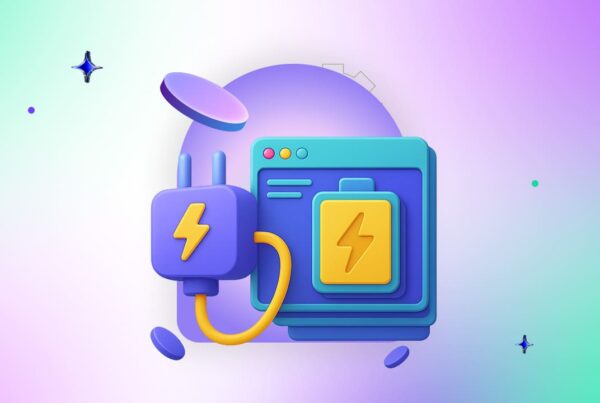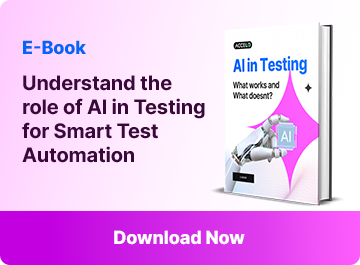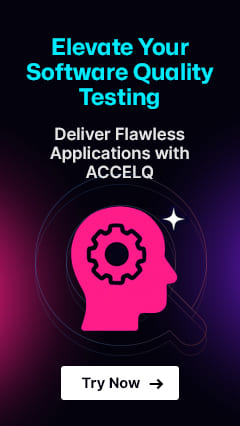Why Everyone’s Talking About AI in QA (But Few Are Doing It Right)

The hype around AI in QA is higher for better reasons. AI in QA automation offers quicker, smarter, and more robust tests as software delivery cycles shorten and systems become more complex. AI in QA testing is revolutionizing the way QA is done, from predictive analytics to intelligent test generation. Teams are intrigued by the possibilities, but only a few are truly adopting Artificial Intelligence (AI) effectively, gaining real-time value rather than following the trend.
- What is the reason for the growing popularity of AI in quality assurance?
- Common Errors and Misconceptions
- How Does AI in QA "Right" Look Like?
- Real-World Use Cases of AI in QA
- ACCELQ Leading the Way
- How to use AI in QA testing?
- AI QA Testers: Ensuring quality and efficiency in Software Testing
- Conclusion
What is the reason for the growing popularity of AI in quality assurance?
The increasing complexity of software systems, such as multi-platform deployments, rapid CI/CD pipelines, and microservices architectures, is making it difficult for traditional testing methods to keep pace. This is where AI in QA testing is transforming the landscape. AI adds intelligence and agility to quality assurance efforts by identifying patterns, analyzing large datasets, and dynamically adapting test strategies.
Organizations are increasingly embracing AI in QA automation testing to automate repetitive tasks, predict high-risk areas, and streamline processes. In today’s fast-moving digital world, efficiency is critical, not just for speed, but also for staying competitive with software that performs reliably across diverse platforms.
Common Errors and Misconceptions
Despite growing interest, some QA engineering teams still misinterpret the role of AI in quality assurance. A common myth is that simply adding artificial intelligence will magically fix flawed processes or instantly replace manual testing. In reality, AI in quality assurance requires clean data, a well-defined strategy, and seamless integration with existing systems to be truly effective. Overdependence on Artificial Intelligence (AI) in Software Test Automation without manual oversight, treating it as a plug-and-play solution, and overlooking model bias are common drawbacks that result in failed applications and inflated hopes.
How Does AI in QA “Right” Look Like?
Effectively employing artificial intelligence in QA is not about chasing hype; it’s about mitigating actual issues with smart automation. Skilled experts harness AI in QA to arrange test cases based on risk, automatically create test scripts from requirements, and allow self-healing testing that adjusts to User Interface changes. The role of AI in quality assurance is strategic; it expedites processes and improves decision-making, rather than substituting human effort.
Real-World Use Cases of AI in QA
The execution of AI in software quality assurance isn’t merely theoretical; it is resolving actual issues today. A standout example is self-healing automation, where Artificial Intelligence (AI) automatically updates User Interface (UI) scripts when changes occur in the interface, eliminating the need for regular human maintenance. Other use cases comprise smart test prioritization based on risk scrutiny, changing plain-text requirements into implementable test cases through NLP (natural language processing), and anomaly detection in test results.
These actual test scenarios demonstrate how AI in QA minimizes overhead and improves speed without compromising quality.
ACCELQ Leading the Way
Various Artificial Intelligence Testing Tools In 2025, for quality assurance, we are supporting QA engineers to expedite and modernize software testing. Let us find out some standout platforms:
ACCELQ—AI-Centric, No-Code Automated Testing
- Introduced for web, desktop, API, & mobile automated tests.
- Predictive analytics enhances coverage & release confidence.
- Supports shift-left testing & allows QA engineers without coding expertise.
- Self-healing testing decreases manual script maintenance.
- Incorporates with CI/CD pipelines for continuous testing.
- Perfect for executing AI in software quality assurance across enterprise applications.
How to use AI in QA testing?
Successfully implementing AI in QA necessitates a pragmatic & strategic method. Let us find a roadmap for teams seeking to embrace AI in software testing efficiently:

1. Define Goals & KPIs
Identify the ideal areas to use artificial intelligence (AI), such as ranking test cases, automating UI stability, or predicting mistake detection, and establish quantifiable goals.
2. Learn Rapidly, Pilot Small
Start with a low-risk test area, such as self-healing User Interface (UI) scripts or API validation in a contained service. Before increasing the use of AI, get information and make adjustments.
3. Expense in Team Upskilling
Equip QA testers and AI QA testers with expertise in model behavior, data know-how, and interpreting AI-centric insights. Training is crucial for allowing these human-in-the-loop systems.
4. Pick the Accurate AI Tools
Embrace AI tools for quality assurance, such as ACCELQ. Choose platforms that integrate into your CI/CD pipeline & assist AI in QA automation testing.
5. Integrate AI Deeply into the SDLC
Combine QA perfectly with AI-assisted testing, integrating with builds, automating early on, and verifying feedback loops.
6. Scrutinize, Measure, and Refine
Monitor AI’s effects on a regular basis, employing techniques such as test maintenance savings, error rates, and time-to-resolution.
By following this outline, QA experts, specifically AI QA testers, can employ AI effectively, adaptively, and purposefully.
AI QA Testers: Ensuring quality and efficiency in Software Testing
AI QA testers play a critical role in augmenting both the accuracy and quality of software delivery. By leveraging predictive analytics, ML, and smart automation, these AI-centric tools help QA teams find errors and bugs early, produce optimized test cases, and adjust to changes in real time. Unlike outdated testing methods, AI QA testers learn from data patterns, enabling them to reduce redundant efforts and prioritize high-risk areas, guaranteeing effective, scalable, and consistent testing across platforms.
Conclusion
Enterprises that implement AI in software quality assurance are unlocking fresh levels of productivity and precision. Expert or skilled teams combine manual expertise with the power of AI in Testing Automation to attain rapid delivery, smarter error identification, and decreased maintenance overhead. Platforms such as ACCELQ represent how AI tools for quality assurance can elevate the QA test process from mundane to strategic.
For AI QA testers seeking how to use AI in QA automation testing? This revolution means working intelligently, not harder. AI frees up QA engineers from data-driven tasks to concentrate on ethical oversight, user experience, and exploratory testing. When done accurately, artificial intelligence in QA is a robust amplifier, changing quality into a competitive gain.
The future of QA is not just automated; it’s smart. Are you ready to do AI in QA automation the right way? Browse the Contact Us page now!!
Geosley Andrades
Director, Product Evangelist at ACCELQ
Geosley is a Test Automation Evangelist and Community builder at ACCELQ. Being passionate about continuous learning, Geosley helps ACCELQ with innovative solutions to transform test automation to be simpler, more reliable, and sustainable for the real world.
You Might Also Like:
 AI Test Automation for nCino | Powering Fintech Innovation
AI Test Automation for nCino | Powering Fintech Innovation
AI Test Automation for nCino | Powering Fintech Innovation
 AI Automation in Testing: The Future of Smarter, Scalable QA
AI Automation in Testing: The Future of Smarter, Scalable QA
AI Automation in Testing: The Future of Smarter, Scalable QA
 Supercharge Testing with AI: Automate & Accelerate Efficiency
Supercharge Testing with AI: Automate & Accelerate Efficiency


































